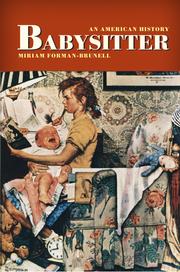Check nearby libraries
Buy this book

It’s Friday night and Mom and Dad want to have a little fun together on the town. But who can they call to watch the kids? For nearly a century, it’s been the babysitter. Miriam Forman-Brunell brings critical attention to the ubiquitous, yet long-overlooked, role of the babysitter in American history.
Drawing on her extensive research on the history of girls’ culture and employing a broad range of vibrant sources, Forman-Brunell analyzes the figure of the babysitter in the popular imagination. In her quest to gain a fuller picture of this largely uncharted cultural phenomenon, she amassed a wealth of popular artifacts and texts from which to draw: the Babysitter’s Club book series, songs such as the Lunachicks’ "Babysitters on Acid" and the 1960s hit "Baby Sittin’ Boogie," the Little Lulu cartoons, Barbie doll babysitting accessories, the suburban horror movie The Hand That Rocks the Cradle, urban legends, magazines, newspapers, television shows and more. What emerges is a fascinating and multifaceted history.
Forman-Brunell shows that in addition to the obvious fears involved in leaving one’s children in another’s care, babysitters have often been targets for social, cultural, generational, and sexual anxieties, and thus present a fascinating mirror for American society. She also delves into the world of the babysitters, gaining important new perspectives on how the American teenage girl responded to the roles and responsibilities placed upon her throughout the decades.
Maligned as incompetents, airheads, home-wreckers, and worse, babysitters have played an important part in the history of the American home and workforce. With this comprehensive, insightful, and even-handed study, they finally get the attention they deserve.
Check nearby libraries
Buy this book

Previews available in: English
| Edition | Availability |
|---|---|
| 1 |
aaaa
Libraries near you:
WorldCat
|
Book Details
First Sentence
"“A good babysitter is hard come by,” explained a reporter on CBS News during the summer of 2007. A year earlier, a mother blogged that “babysitters seem to care nothing about kids and charge $16 an hour to watch TV and text message their boyfriends.” And then, of course, reported Living Safely magazine in the 1990s, there were the “horror stories: parents arriving home to find their sitter has thrown a party, or gone to one. . . .” Intrinsic to such typical complaints is a longing for the golden age of babysitting when teenage girls were both pleasant and plentiful. Yet the view that babysitters today are hard to take and even harder to find is not new. In a letter to “Dear Abby” in 1969, one woman described the batch of hungry sitters “who ate the fridge to the bare walls” and disparaged the one with “the gall” to raid the “deep freeze.” What is unknown to these recent observers is that a prior idyllic age of babysitting is more apparent than real: distressed parent-employers have suspected their sitters of doing wrong ever since the beginning of babysitting nearly one hundred years ago. In fact, parent-employers have been complaining about babysitters since the advent of the “modern” American teenage girl, a debut that coincided with the creation of babysitting, the job that defaulted to white, middle-class, female adolescents by virtue of their sex, race, class, and age."
Table of Contents
Edition Notes
Includes bibliographical references and index.
Classifications
The Physical Object
ID Numbers
Source records
Library of Congress MARC recordLibrary of Congress MARC record
Library of Congress MARC record
Library of Congress MARC record
Internet Archive item record
marc_openlibraries_sanfranciscopubliclibrary MARC record
Better World Books record
Library of Congress MARC record
marc_columbia MARC record
harvard_bibliographic_metadata record
marc_nuls MARC record
Community Reviews (0)
Feedback?| August 2, 2020 | Edited by ImportBot | import existing book |
| May 23, 2019 | Edited by MARC Bot | import existing book |
| April 30, 2018 | Created by ImportBot | import new book |











